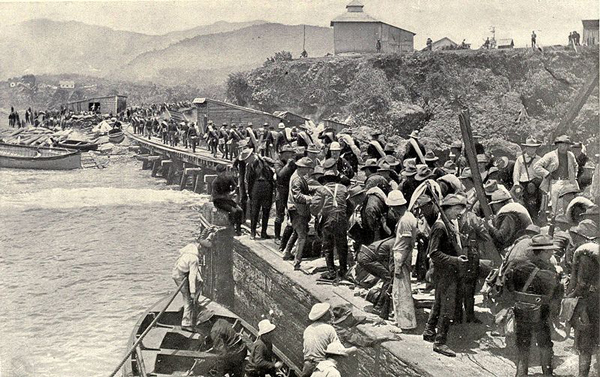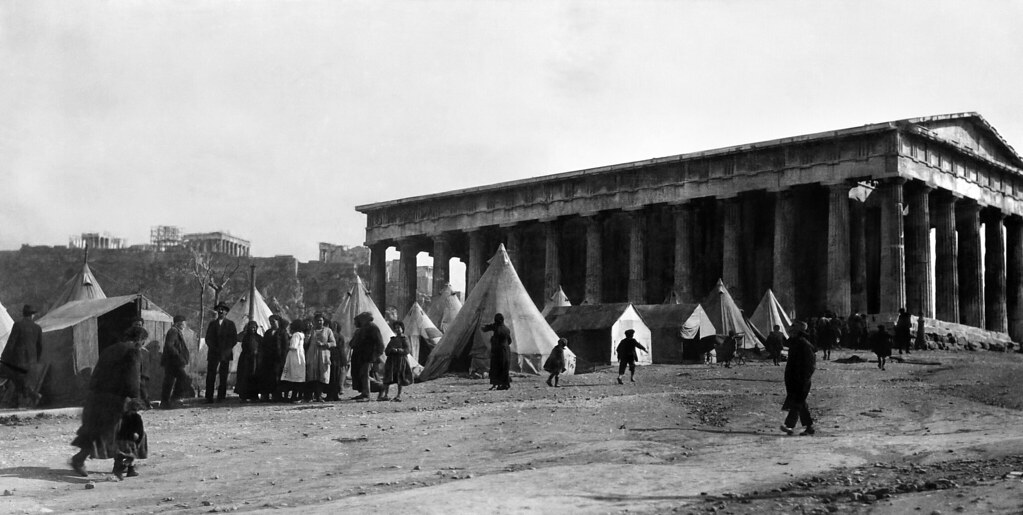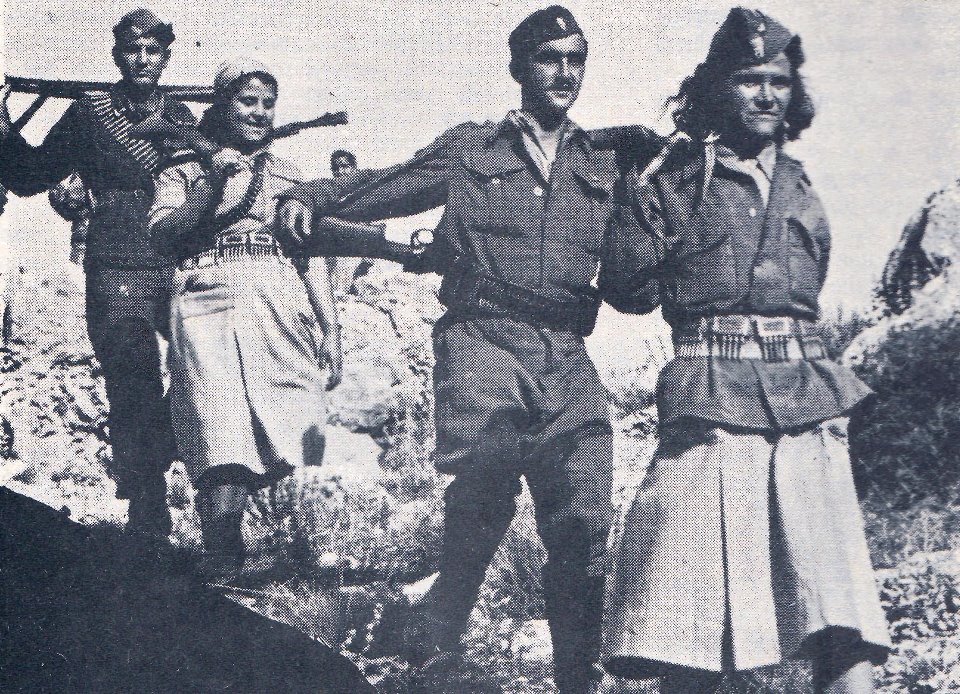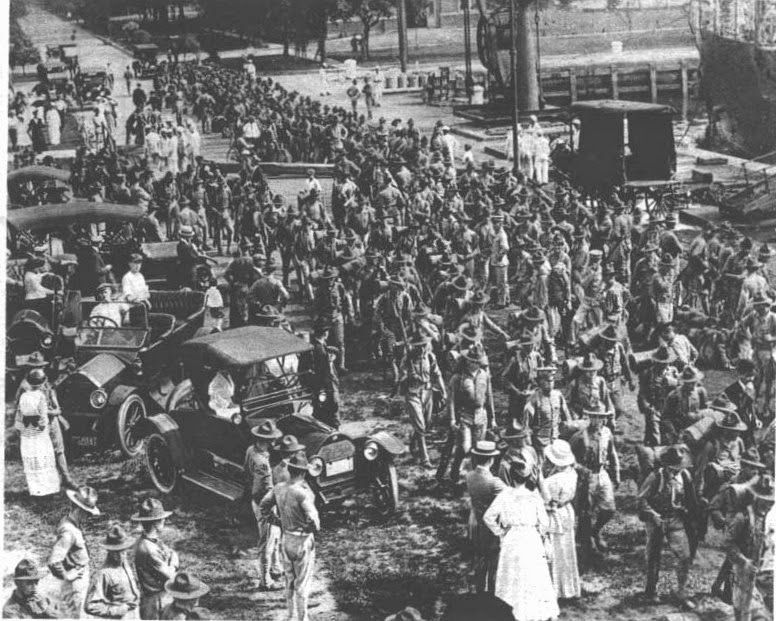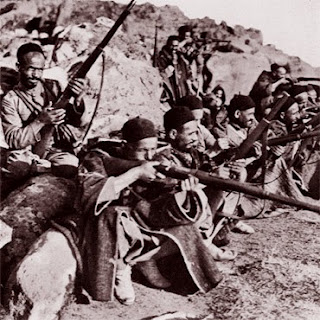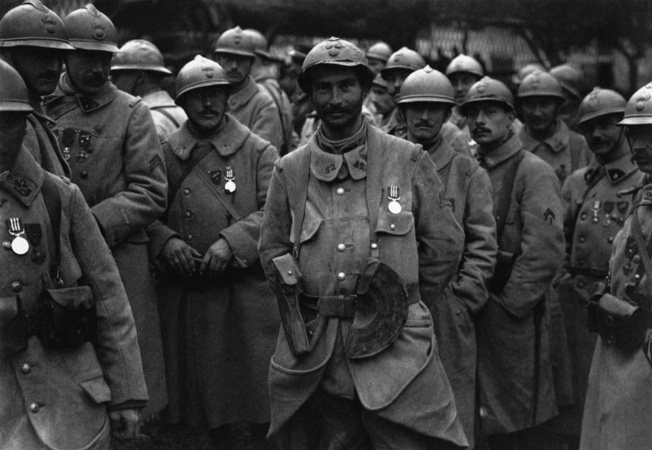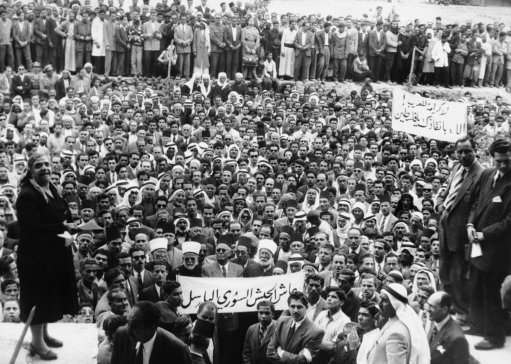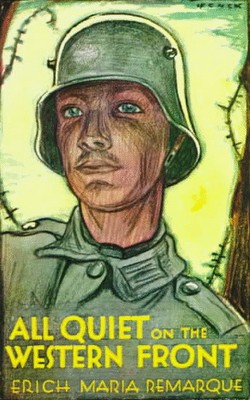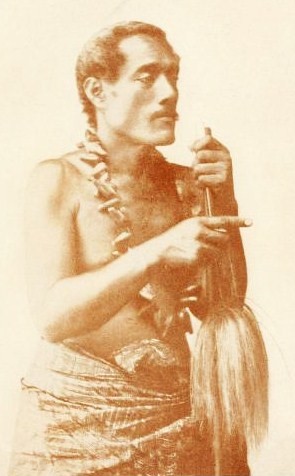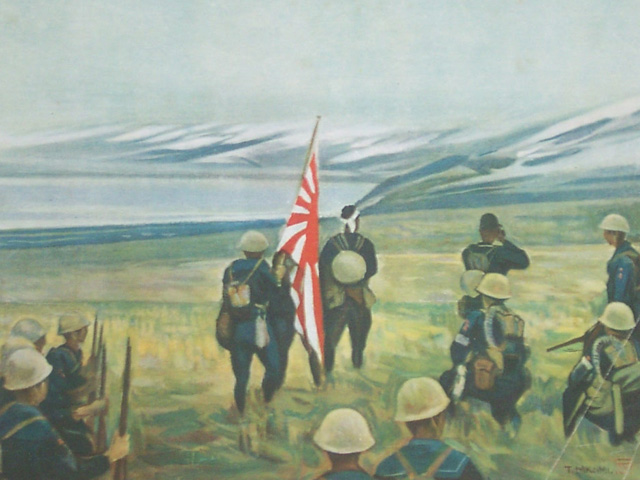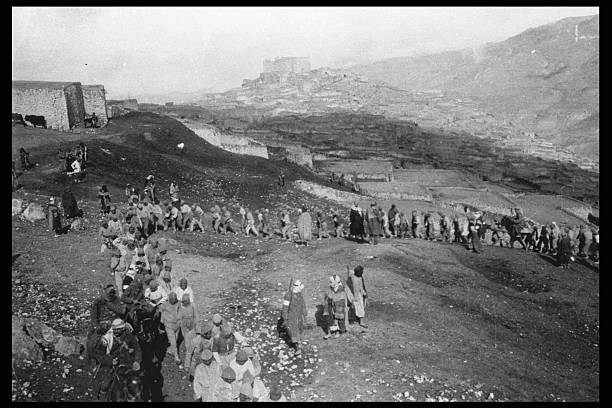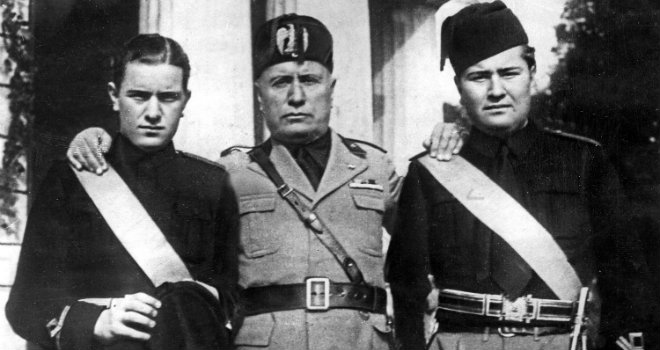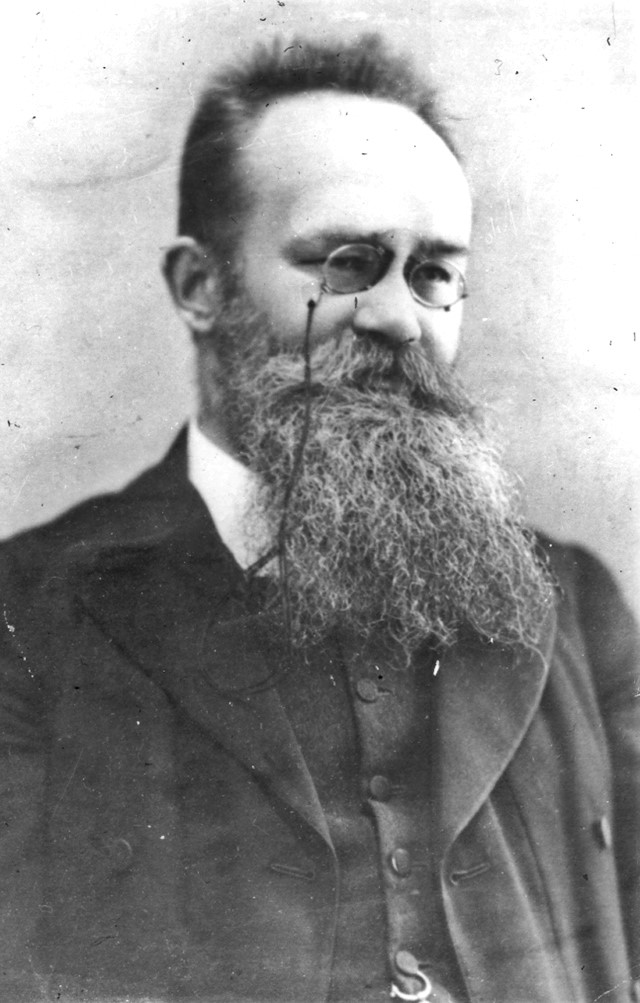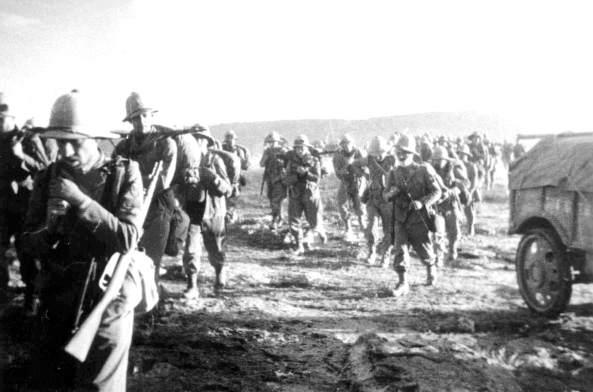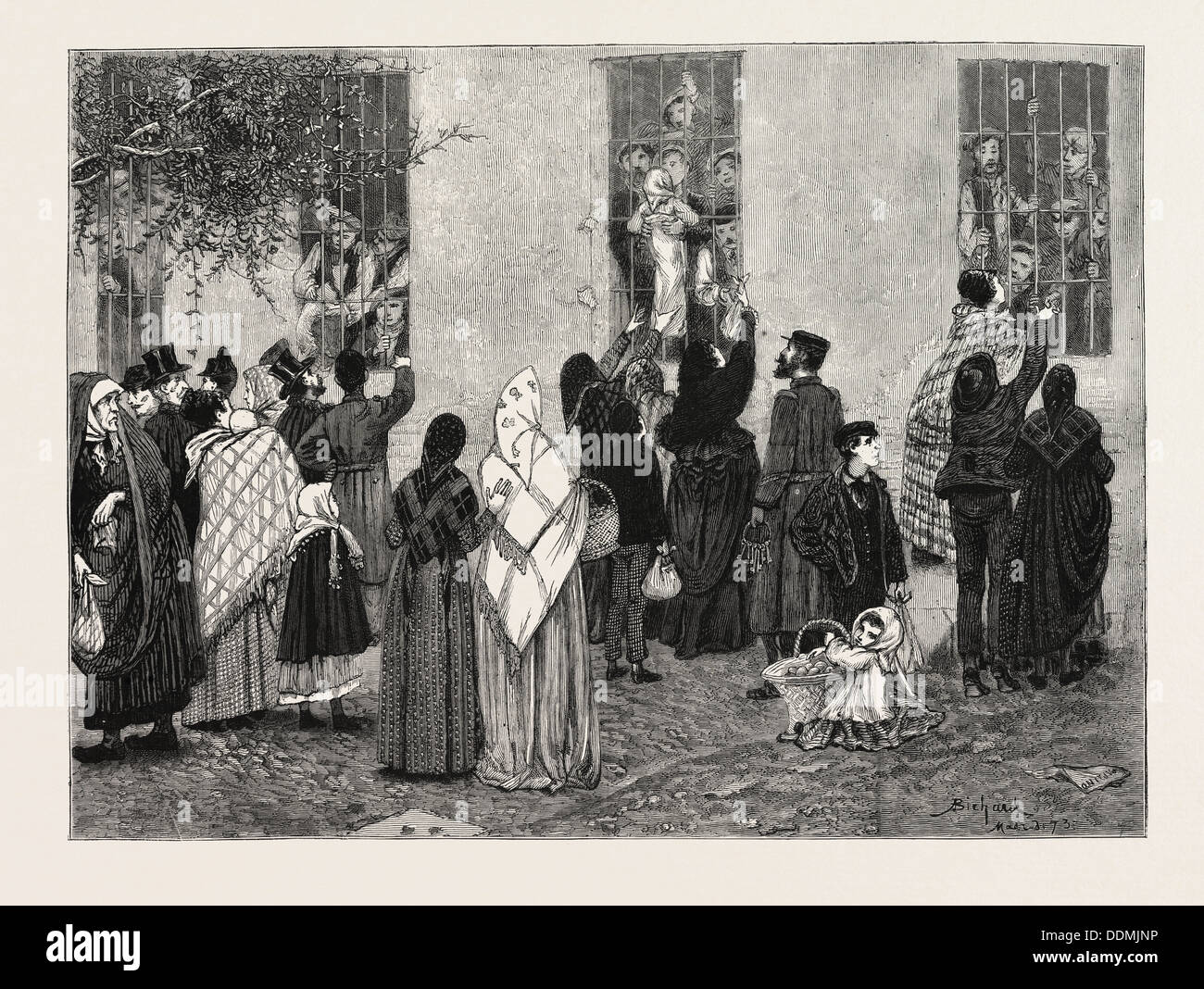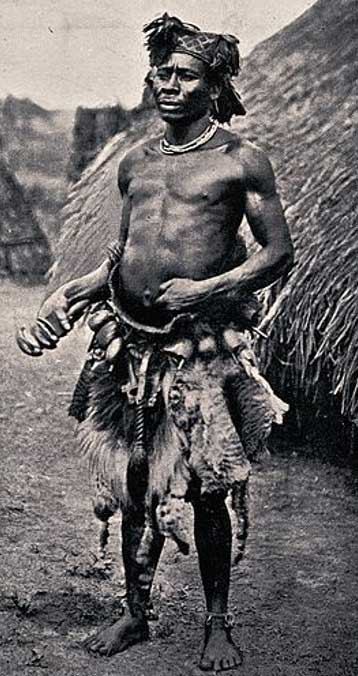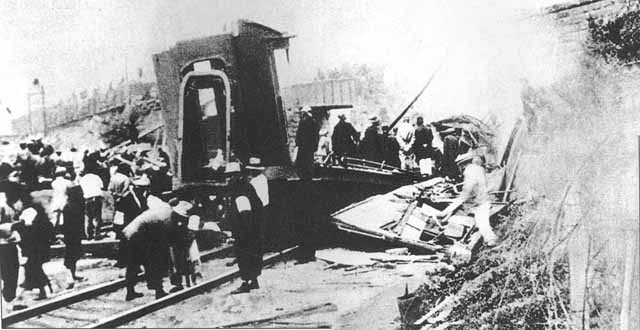The June uprising: the wolf struggle against the two headed black eagle
Despite the various successes of the young Albanian state, the government wasn't stable at all. Albanian governments appeared and disappeared in rapid succession. Between July and December 1921 alone, the premiership changed hands five times.
The Popular Party's head, Xhafer Ypi, formed a government in December 1921 with Fan S. Noli as foreign minister and Ahmed Bey Zogu as internal affairs minister, but Noli resigned soon after Zogu resorted to repression in an attempt to disarm the lowland Albanians despite the fact that bearing arms was a traditional custom. When the government's enemies attacked Tirana in early 1922, Zogu stayed in the capital and, with the support of the Italian ambassador, repulsed the assault. He took over the premiership later in the year and turned his back on the Popular Party by announcing his engagement to the daughter of the Progressive Party leader, Shefqet Verlaci. Zogu's protégés organized themselves into the Government Party. Noli and other Western-oriented leaders formed the Opposition Party of Democrats, which attracted all of Zogu's many personal enemies, ideological opponents, and people left unrewarded by his political machine. Ideologically, the Democrats included a broad sweep of people who advocated everything from conservative Islam to Noli's dreams of rapid modernization.
Opposition to Zogu was formidable. Orthodox peasants in Albania's southern lowlands loathed Zogu because he supported the Muslim landowners' efforts to block land reform; Shkodër's citizens felt shortchanged because their city did not become Albania's capital, and many criticized him for his support by the fascists. As a matter of fact, many believed that Zogu turned Albania in an Italian protectorate. Thanks to the Treaty of Rome, Albania was recognized as an independent country, and all Montenegran, Serbian and Greek areas with Albanian majorities and minorities were integrated into the Greater Albanian State or GAS (Shteti i Madh Shqiptar, or SMS). However, the Treaty also allowed many benefits for the Austro-Hungarians and the Italians, which soon started to implement spheres of influences in the region, similar to the ones present in China and pre-Spanish Deal Siam. The Albanian public opinion was also upset after the Italian seizure of Corfu and several other Greek islands. Because of this, the Italian sphere of influences grew in size. In these zones, Italians had better trade deals with the Albanese, and also hosted troops in the various regions, just like the United States of Greater Austria did. One zone in the middle, including the capital, was left intact in order to avoid conflicts between the USGA and the Kingdom of Italy. Despite the Austrian strong interests in the Nord, the Italians were the true rulers of the young Kingdom, having large armies in cities such as Berat.

The Kingdom of Albania, with the Italian sphere of influence in the South and the USGA sphere in the Nord. In reality, the Italian sphere of influence was present in the entirety of the country de facto, and some nationalists claimed that Albania was merely an Italian puppet state.
Zogu's party handily won elections for a National Assembly in early 1924. Zogu soon stepped aside, however, handing over the premiership to Verlaci in the wake of a financial scandal and an assassination attempt by a young radical that left Zogu wounded. The opposition withdrew from the assembly after the leader of a radical youth organization and popular liberal leftist politician, Avni Rustemi, was murdered in the street outside the parliament building.
Noli's supporters blamed the murder of Avni Rustemi on Zogu's Mati clansmen, who continued to practice blood vengeance. After the walkout, discontent mounted, and in June 1924 a peasant-backed insurgency had won control of Tirana. Noli became prime minister, and Zogu fled to Italy.
Fan Noli, an idealist, rejected demands for new elections on the grounds that Albania needed a "paternal" government. In a manifesto describing his government's program, Noli called for abolishing feudalism, resisting Italian domination, and establishing a Western-style constitutional government. Scaling back the bureaucracy, strengthening local government, assisting peasants, throwing Albania open to foreign investment, freeing the Nord from the Austrian grasps, and improving the country's bleak transportation, public health, and education facilities filled out the Noli government's overly ambitious agenda. Noli encountered resistance to his program from people who had helped him oust Zogu, and he never attracted the foreign aid necessary to carry out his reform plans. On top of that, Italian prime minister Benito Mussolini was resentful of Noli's government, and tensions between the Kingdom of Albania and the Kingdom of Italy after several incidents in the island of Sazan, where an Albanian uprising backed up by the Albanian government killed 30 Italian colonists and injured 10 of them, in what is today known as "the massacre of Sazan(Il massacro di Saseno).

Italian troops, which arrived shortly to suppress the Albanian revolt in Sazan, walk among the bodies of Italian civilians killed by Albanian rebels. These were higly supported by the Albanian government, which was resentful of Italy strong position in the area, and its full controll of islands with an Albanian majority.
Under Fan Noli, the government set up a special tribunal that passed death sentences, in absentia, on Zogu, Verlaci, and others and confiscated their property. After Noli's regime decided to establish diplomatic relations with the Ottoman empire, a bitter economic enemy of the Kingdom of Italy, the Italians started to mobilize. In Italy, Zogu recruited a mercenary army, and Rome furnished the Albanian leader with weapons, about 1,000 Italian Army regulars, and Austrian members to mount an invasion that the Italians hoped would resolve the situation in Albania. The Italians needed Zogu, if they wanted to maintain controll over Albania. The most experienced of these forces was the Italian contingent, which was led by Italian General Ubaldo Soddu, who actually saw combat in Albania in the Albano-Greek war. Its contingent consisted of 102 soldiers, including 15 officers. Zogu was recommended by the Italians to have Armando Diaz, a World War I veteran who commanded the Italian army in the Sicilian campaign(famous its orders in the battle of Locogrande:"Men, I'm not ordering you to attack. I'm ordering you to die.), in leading the contingent. On 13 December 1924, Zogu's Italian-backed army landed into Albanian territory. The Italian army, however, decided to give an additional "push" to support Zogu.

Ahmed Bey Zogu, also better known by many as "Mussolini little dog(Il cagnetto di Mussolini, Mussolini qen i vogel)", because of his affinity to the Italian fascist government
On July 7 Mussolini's troops, led by General Alfredo Guzzoni, invaded Albania, attacking all Albanian ports simultaneously. The Italian naval forces involved in the invasion consisted of the battleships Giulio Cesare and Conte di Cavour, three heavy cruisers, three light cruisers, nine destroyers, fourteen torpedo boats, one minelayer, ten auxiliary ships and nine transport ships. The ships were divided into four groups, that carried out landings in Vlore, Durres, Sarande and Shengjin.
On the other side the regular Albanian army had 15,000 poorly equipped troops who had been trained by Italian officers. Noli's plan was to mount a resistance in the mountains, leaving the ports and main cities undefended; but Italian agents placed in Albania as military instructors sabotaged this plan. The Albanians discovered that artillery pieces had been disabled and there was no ammunition. As a consequence, the main resistance was offered by gendarmes and small groups of patriots.
In Durrës, a force of 500 Albanians, including gendarmes and armed volunteers, led by Major Abaz Kupi (the commander of the gendarmerie in Durrës), and Mujo Ulqinaku, a naval sergeant, tried to halt the Italian advance. Equipped with small arms and three machine guns and supported by a coastal battery, the defenders resisted for a few hours before being overcome with the help of naval gunfire. The Albanian Navy stationed in Durrës consisted of four patrol boats (each armed with a machine gun) and a coastal battery with four 75 mm guns, the latter also being involved in the fighting. Mujo Ulqinaku, the commander of the patrol boat Tiranë, used his machine gun to kill and wound many Italian troops until himself being killed by an artillery shell from an Italian warship.
By 1:30 pm on the first day, all Albanian ports were in Italian hands. That same day Noli fled to Bulgaria, taking with him part of the gold reserves of the Albanian Central Bank. On hearing the news, an angry mob attacked the prisons, liberated the prisoners and sacked the Prime Minister residence At 9:30 am on July 8, Italian troops entered Tirana and quickly captured all government buildings. Italian columns of soldiers then marched to Shkodër, Fier and Elbasan. Shkodër surrendered in the evening after 12 hours of fighting. However, two officers garrisoned at Rozafa castle refused to obey the ceasefire order and continued to fight until they ran out of ammunition. The Italian troops later paid homage to the Albanian troops in Shkodër who had halted their advance for an entire day. During the Italian advance in Shkodër the mob besieged the prison and liberated some 200 prisoners.
On July 12, the Albanian parliament voted to depose Noli, and decided to welcome Zogu back as the ruler of the nation. The parliament elected Albania's largest landowner, Shefqet Vërlaci, as Prime Minister. Peace talks would be written on Tirana. In it:
-Albania recognize the Italian sphere of influence in the South
-Albania recognize the Italian ownship of the Albanian islands
-Zogu becomes the King of Albania, condemning Albania to be De Facto an Italian puppet state
-the Kingdom of Italy occupies the port of Orikum and the Karaburun Peninsula

Map of Albania after the Italian invasion
After Mussolini intervention in the region, it was obvious that the Italian government had aggressive and imperialistic intention, but was still well seen by the German government, who saw the Italians as a powerful ally in the Mediterranean, as relations between the Ottoman empire and the German empire become more and more stagnant.
I hope you guys like this new update! Be sure to like(if you like it), comment(please comment so I can learn what your opinion is) and.....follow I guess.
Despite the various successes of the young Albanian state, the government wasn't stable at all. Albanian governments appeared and disappeared in rapid succession. Between July and December 1921 alone, the premiership changed hands five times.
The Popular Party's head, Xhafer Ypi, formed a government in December 1921 with Fan S. Noli as foreign minister and Ahmed Bey Zogu as internal affairs minister, but Noli resigned soon after Zogu resorted to repression in an attempt to disarm the lowland Albanians despite the fact that bearing arms was a traditional custom. When the government's enemies attacked Tirana in early 1922, Zogu stayed in the capital and, with the support of the Italian ambassador, repulsed the assault. He took over the premiership later in the year and turned his back on the Popular Party by announcing his engagement to the daughter of the Progressive Party leader, Shefqet Verlaci. Zogu's protégés organized themselves into the Government Party. Noli and other Western-oriented leaders formed the Opposition Party of Democrats, which attracted all of Zogu's many personal enemies, ideological opponents, and people left unrewarded by his political machine. Ideologically, the Democrats included a broad sweep of people who advocated everything from conservative Islam to Noli's dreams of rapid modernization.
Opposition to Zogu was formidable. Orthodox peasants in Albania's southern lowlands loathed Zogu because he supported the Muslim landowners' efforts to block land reform; Shkodër's citizens felt shortchanged because their city did not become Albania's capital, and many criticized him for his support by the fascists. As a matter of fact, many believed that Zogu turned Albania in an Italian protectorate. Thanks to the Treaty of Rome, Albania was recognized as an independent country, and all Montenegran, Serbian and Greek areas with Albanian majorities and minorities were integrated into the Greater Albanian State or GAS (Shteti i Madh Shqiptar, or SMS). However, the Treaty also allowed many benefits for the Austro-Hungarians and the Italians, which soon started to implement spheres of influences in the region, similar to the ones present in China and pre-Spanish Deal Siam. The Albanian public opinion was also upset after the Italian seizure of Corfu and several other Greek islands. Because of this, the Italian sphere of influences grew in size. In these zones, Italians had better trade deals with the Albanese, and also hosted troops in the various regions, just like the United States of Greater Austria did. One zone in the middle, including the capital, was left intact in order to avoid conflicts between the USGA and the Kingdom of Italy. Despite the Austrian strong interests in the Nord, the Italians were the true rulers of the young Kingdom, having large armies in cities such as Berat.
The Kingdom of Albania, with the Italian sphere of influence in the South and the USGA sphere in the Nord. In reality, the Italian sphere of influence was present in the entirety of the country de facto, and some nationalists claimed that Albania was merely an Italian puppet state.
Zogu's party handily won elections for a National Assembly in early 1924. Zogu soon stepped aside, however, handing over the premiership to Verlaci in the wake of a financial scandal and an assassination attempt by a young radical that left Zogu wounded. The opposition withdrew from the assembly after the leader of a radical youth organization and popular liberal leftist politician, Avni Rustemi, was murdered in the street outside the parliament building.
Noli's supporters blamed the murder of Avni Rustemi on Zogu's Mati clansmen, who continued to practice blood vengeance. After the walkout, discontent mounted, and in June 1924 a peasant-backed insurgency had won control of Tirana. Noli became prime minister, and Zogu fled to Italy.
Fan Noli, an idealist, rejected demands for new elections on the grounds that Albania needed a "paternal" government. In a manifesto describing his government's program, Noli called for abolishing feudalism, resisting Italian domination, and establishing a Western-style constitutional government. Scaling back the bureaucracy, strengthening local government, assisting peasants, throwing Albania open to foreign investment, freeing the Nord from the Austrian grasps, and improving the country's bleak transportation, public health, and education facilities filled out the Noli government's overly ambitious agenda. Noli encountered resistance to his program from people who had helped him oust Zogu, and he never attracted the foreign aid necessary to carry out his reform plans. On top of that, Italian prime minister Benito Mussolini was resentful of Noli's government, and tensions between the Kingdom of Albania and the Kingdom of Italy after several incidents in the island of Sazan, where an Albanian uprising backed up by the Albanian government killed 30 Italian colonists and injured 10 of them, in what is today known as "the massacre of Sazan(Il massacro di Saseno).
Italian troops, which arrived shortly to suppress the Albanian revolt in Sazan, walk among the bodies of Italian civilians killed by Albanian rebels. These were higly supported by the Albanian government, which was resentful of Italy strong position in the area, and its full controll of islands with an Albanian majority.
Under Fan Noli, the government set up a special tribunal that passed death sentences, in absentia, on Zogu, Verlaci, and others and confiscated their property. After Noli's regime decided to establish diplomatic relations with the Ottoman empire, a bitter economic enemy of the Kingdom of Italy, the Italians started to mobilize. In Italy, Zogu recruited a mercenary army, and Rome furnished the Albanian leader with weapons, about 1,000 Italian Army regulars, and Austrian members to mount an invasion that the Italians hoped would resolve the situation in Albania. The Italians needed Zogu, if they wanted to maintain controll over Albania. The most experienced of these forces was the Italian contingent, which was led by Italian General Ubaldo Soddu, who actually saw combat in Albania in the Albano-Greek war. Its contingent consisted of 102 soldiers, including 15 officers. Zogu was recommended by the Italians to have Armando Diaz, a World War I veteran who commanded the Italian army in the Sicilian campaign(famous its orders in the battle of Locogrande:"Men, I'm not ordering you to attack. I'm ordering you to die.), in leading the contingent. On 13 December 1924, Zogu's Italian-backed army landed into Albanian territory. The Italian army, however, decided to give an additional "push" to support Zogu.

Ahmed Bey Zogu, also better known by many as "Mussolini little dog(Il cagnetto di Mussolini, Mussolini qen i vogel)", because of his affinity to the Italian fascist government
On July 7 Mussolini's troops, led by General Alfredo Guzzoni, invaded Albania, attacking all Albanian ports simultaneously. The Italian naval forces involved in the invasion consisted of the battleships Giulio Cesare and Conte di Cavour, three heavy cruisers, three light cruisers, nine destroyers, fourteen torpedo boats, one minelayer, ten auxiliary ships and nine transport ships. The ships were divided into four groups, that carried out landings in Vlore, Durres, Sarande and Shengjin.
On the other side the regular Albanian army had 15,000 poorly equipped troops who had been trained by Italian officers. Noli's plan was to mount a resistance in the mountains, leaving the ports and main cities undefended; but Italian agents placed in Albania as military instructors sabotaged this plan. The Albanians discovered that artillery pieces had been disabled and there was no ammunition. As a consequence, the main resistance was offered by gendarmes and small groups of patriots.
In Durrës, a force of 500 Albanians, including gendarmes and armed volunteers, led by Major Abaz Kupi (the commander of the gendarmerie in Durrës), and Mujo Ulqinaku, a naval sergeant, tried to halt the Italian advance. Equipped with small arms and three machine guns and supported by a coastal battery, the defenders resisted for a few hours before being overcome with the help of naval gunfire. The Albanian Navy stationed in Durrës consisted of four patrol boats (each armed with a machine gun) and a coastal battery with four 75 mm guns, the latter also being involved in the fighting. Mujo Ulqinaku, the commander of the patrol boat Tiranë, used his machine gun to kill and wound many Italian troops until himself being killed by an artillery shell from an Italian warship.
By 1:30 pm on the first day, all Albanian ports were in Italian hands. That same day Noli fled to Bulgaria, taking with him part of the gold reserves of the Albanian Central Bank. On hearing the news, an angry mob attacked the prisons, liberated the prisoners and sacked the Prime Minister residence At 9:30 am on July 8, Italian troops entered Tirana and quickly captured all government buildings. Italian columns of soldiers then marched to Shkodër, Fier and Elbasan. Shkodër surrendered in the evening after 12 hours of fighting. However, two officers garrisoned at Rozafa castle refused to obey the ceasefire order and continued to fight until they ran out of ammunition. The Italian troops later paid homage to the Albanian troops in Shkodër who had halted their advance for an entire day. During the Italian advance in Shkodër the mob besieged the prison and liberated some 200 prisoners.
On July 12, the Albanian parliament voted to depose Noli, and decided to welcome Zogu back as the ruler of the nation. The parliament elected Albania's largest landowner, Shefqet Vërlaci, as Prime Minister. Peace talks would be written on Tirana. In it:
-Albania recognize the Italian sphere of influence in the South
-Albania recognize the Italian ownship of the Albanian islands
-Zogu becomes the King of Albania, condemning Albania to be De Facto an Italian puppet state
-the Kingdom of Italy occupies the port of Orikum and the Karaburun Peninsula
Map of Albania after the Italian invasion
After Mussolini intervention in the region, it was obvious that the Italian government had aggressive and imperialistic intention, but was still well seen by the German government, who saw the Italians as a powerful ally in the Mediterranean, as relations between the Ottoman empire and the German empire become more and more stagnant.
I hope you guys like this new update! Be sure to like(if you like it), comment(please comment so I can learn what your opinion is) and.....follow I guess.



